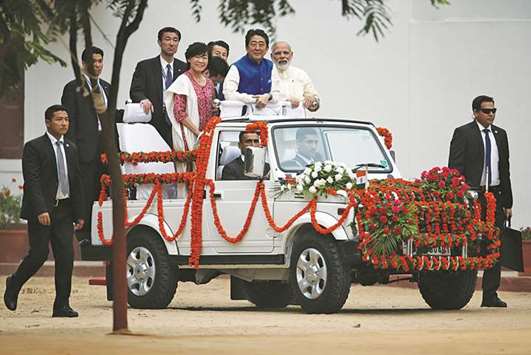The move by Abe, who started a two-day visit to India yesterday, highlights an early lead for Japan in a sector where the Chinese have also been trying to secure a foothold, but without much success.
Modi has made the 500km-long high-speed rail link between the financial hub of Mumbai and the industrial city of Ahmedabad a centrepiece of his efforts to showcase India’s ability to build cutting-edge infrastructure.
The leaders will launch the start of work on the line today, the railways ministry said in a statement.
“This technology will revolutionise and transform the transport sector,” said Railways Minister Piyush Goyal, welcoming the prospects for growth brought by Japan’s high-speed “shinkansen” technology.
Modi, who went to the airport in Ahmedabad to receive Abe, greeted his Japanese counterpart with a warm hug as he disembarked from the aircraft.
Abe – dressed in a blue Indian-style Nehru jacket – along with his wife Aki and Modi later embarked on a roadshow to Sabarmati Ashram, the former home of Mahatma Gandhi.
The two leaders waved to thousands of people who had lined up on roads from an open jeep decorated with flowers.
Along the 9km route, stages were built on which school children held live performances showcasing India’s myriad cultures.
After spending some time at the Ashram, Abe and his wife went to the Sidi Saiyed mosque in the heart of Ahmedabad, guided by Modi.
The 16th century mosque is known the world over for its window filigree work synonymous with Ahmedabad.
The Abes ended the day with a dinner at a heritage hotel, House of MG’s Aghashiye (terrace) restaurant.
In Tokyo, a Japanese foreign ministry official told reporters, “We would like to support ‘Make in India’ as much as possible,” referring to Modi’s signature policy to lure investors in manufacturing.
“And for that, we want to do what’s beyond the Mumbai-Ahmedabad line and achieve economies of scale.”
India would make “all-out efforts” to complete the line by August 2022, more than a year earlier than planned, the government said this week.



